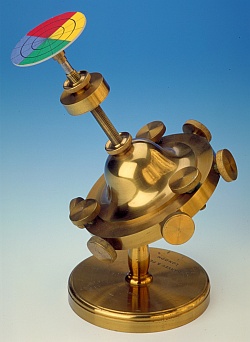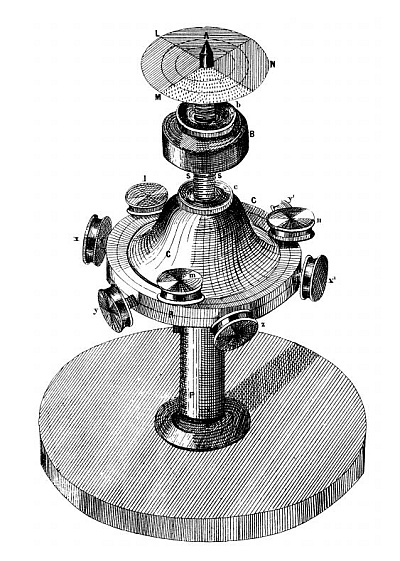 |
Maxwell's Dynamical Top | Maxwell Legacy Concepts |
|---|
In a nutshell |
Maxwell's dynamical top is the Rolls Royce of tops, a precision piece designed for the connoisseur. Maxwell devised the top while a Fellow at Trinity College Cambridge. Its purpose is to demonstrate the sometimes subtle effects of rotational motion that arise from a variety of mass distributions of the rotating body with respect to the axis of rotation. The variations are accomplished by moving the 9 brass screws on the main body and a brass weight on the threaded axis. The main axis extends through the body and ends (out of sight) in a sharp point that fits into an agate cup at the top of the stand post. The top can be adjusted to show steady spinning, precession and nutation. The coloured disk is a clever touch to show that in complex motion the total angular momentum remains constant. Where the total angular momentum axis cuts the disk the colour on the disk can be seen. All other points on the disk rotate around this point, smearing the colours into a greyish blur. Maxwell used the top to show why the Earth's rotation caused the Earth's axis to both precess (in over 20,000 years) and nutate (over about 19 years) These effects result in the slow change in the coordinates of stars in the sky, a minor inconvenience to astronomers, but more importantly a change in the orientation of the Earth's axis relative to its orbit around the Sun. This, over centuries, has a major effect on world climate. A video of the University of Aberdeen's top being spun can be found on the web page of the James Clerk Maxwell Foundation at the time of writing.
|
 |
|---|
| Technical detail | Although predicting the motion of any body under the action of known forces (or sometimes no force) boils down to applying Newton's laws of motion, as Maxwell himself said in 1856: "the motion of the particles of a body freely rotating renders the subject so intricate, that it has never been thoroughly understood by any but the most expert mathematicians." Maxwell credits the inspiration for his top to a presentation read at the Cambridge Philosophical Society in the same month when Maxwell read one of his own contributions on Faraday's lines of force. This was in February 1856. The presentation was by Richard Baldwin Hayward, Fellow of St John's College, Reader in Natural Philosophy in the University of Durham. Hayward emphasised that when rotation was concerned, angular momentum was the key concept (a term that few people had used before), that it was conserved when there was no applied torque on a body and that moments of inertia (and products of inertia) were the important quantities that determined the rotational motion of a body. Maxwell got the message. With the introduction of these concepts, problems in rotating bodies were transformed from those only 'the most expert mathematicians' could tackle to ones that the average university physics student could solve. In fact so routine has it been to use these concepts that neither Hayward not Maxwell get any credit these days for their insight. With the top, Maxwell wanted to demonstrate before people's eyes, without requiring a knowledge of the underlying mathematics, how these ideas made a difference to the behaviour of a freely rotating body. The top was not aimed at students but at those who themselves might wish to explain what was going on. Maxwell described a wooden version to the British Association for the Advancement of Science in the summer of 1856. When he had taken up his Professorship at Aberdeen he refined the design and ordered 5 examples from John Ramage. His own one is still in the Cavendish laboratory; the one he gave to J. D. Forbes, his mentor while he was a student at Edinburgh, is in the Royal Museum of Scotland. The top shown in the picture above is a commercial copy by Harvey and Peake made later in the century and now in the University of Aberdeen's historical instrument collection. Maxwell exhibited his top at the Royal Society of Edinburgh in April 1857 in a presentation entitled "On a Dynamical Top, for exhibiting the phenomena of the motion of a system of invariable form about a fixed point, with some suggestions as to the Earth's motion." A written account appears in the Transactions of the Royal Society of Edinburgh, vol xxi, and of course in Maxwell's collected works. The illustration alongside comes from that account. References: Robert Hayward's article can be found online at https://ia802705.us.archive.org/19/items/transactionsofca10camb/transactionsofca10camb.pdf. Sometimes books published near a discovery explain things more fully than later publications. Probably not easily found is Henry Worms "The Earth and its Mechanism: being an account of the various proofs of the rotation ot the Earth" (Longman, Green, Longman, Roberts, and Green, London, 1862). Worms explains Maxwell's top in detail (sometimes paraphrasing Maxwell's own words) and also has an extensive section on 'the new theory of rotation' initiated by Louis Poinsot (Théorie nouvelle de la rotation des corps, 1834) and developed and promoted by Hayward and Maxwell. It's still not easy going, for this was prior to the routine use of vectors and matrices in mechanics. Worm's book was re-issued in 1980. JSR 2016 |
 |
|---|